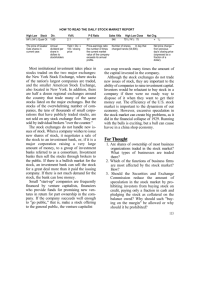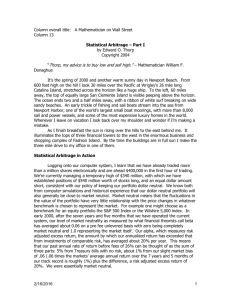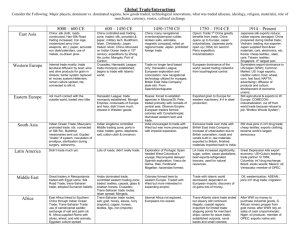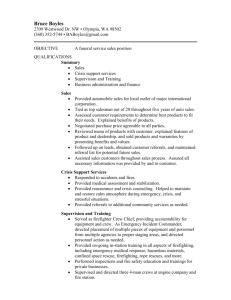Three Methods to Account for Outstanding Stock Options in
advertisement
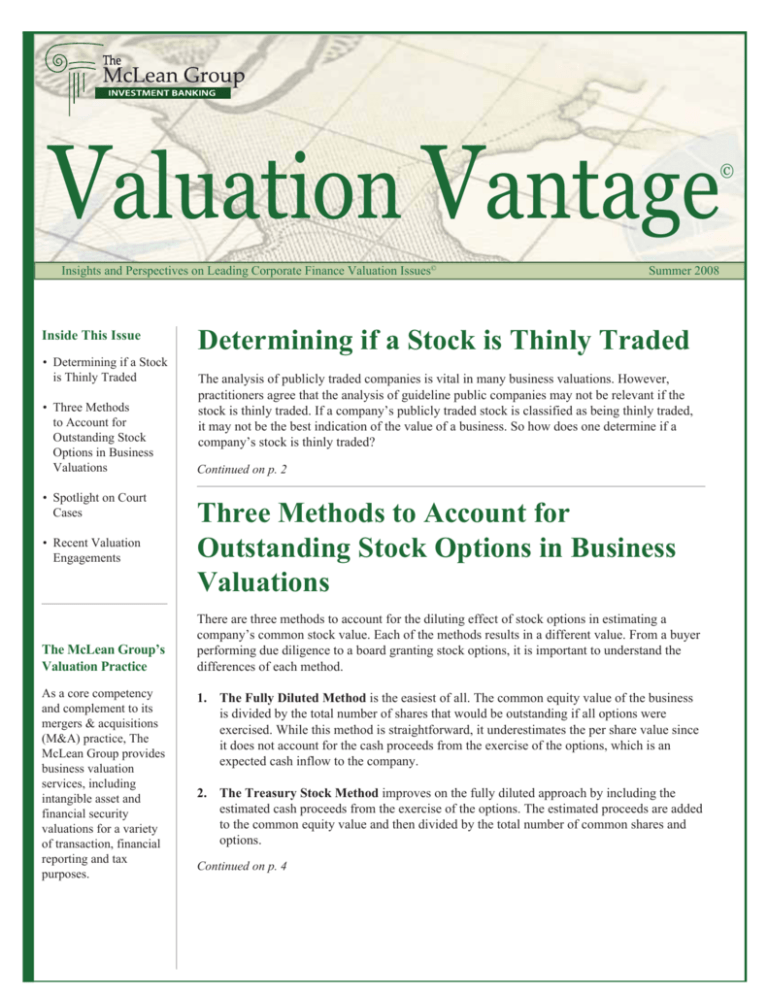
Valuation Vantage Insights and Perspectives on Leading Corporate Finance Valuation Issues© Inside This Issue • Determining if a Stock is Thinly Traded • Three Methods to Account for Outstanding Stock Options in Business Valuations • Spotlight on Court Cases • Recent Valuation Engagements The McLean Group’s Valuation Practice As a core competency and complement to its mergers & acquisitions (M&A) practice, The McLean Group provides business valuation services, including intangible asset and financial security valuations for a variety of transaction, financial reporting and tax purposes. Summer 2008 Determining if a Stock is Thinly Traded The analysis of publicly traded companies is vital in many business valuations. However, practitioners agree that the analysis of guideline public companies may not be relevant if the stock is thinly traded. If a company’s publicly traded stock is classified as being thinly traded, it may not be the best indication of the value of a business. So how does one determine if a company’s stock is thinly traded? Continued on p. 2 Three Methods to Account for Outstanding Stock Options in Business Valuations There are three methods to account for the diluting effect of stock options in estimating a company’s common stock value. Each of the methods results in a different value. From a buyer performing due diligence to a board granting stock options, it is important to understand the differences of each method. 1. The Fully Diluted Method is the easiest of all. The common equity value of the business is divided by the total number of shares that would be outstanding if all options were exercised. While this method is straightforward, it underestimates the per share value since it does not account for the cash proceeds from the exercise of the options, which is an expected cash inflow to the company. 2. The Treasury Stock Method improves on the fully diluted approach by including the estimated cash proceeds from the exercise of the options. The estimated proceeds are added to the common equity value and then divided by the total number of common shares and options. Continued on p. 4 © “Determining if a Stock is Thinly Traded ...” continued from p. 1 In general, there are six attributes that should be analyzed to determine if a stock is thinly traded: 1. Market - The market on which a company’s stock is listed can be an initial indication if it is thinly traded. Thinly traded stocks are often small companies that cannot meet the requirements of larger stock exchanges such as the Nasdaq National Market, the New York Stock Exchange, and the American Stock Exchange. Generally, the majority of stocks that trade on the Nasdaq Small Cap Market (“NasdaqSC”), the Over-The-Counter Bulletin Board (“OTCBB”), or Over-The-Counter Pink Sheets (“OTCPK” or “Other OTC”) often meet the criteria of a thinly traded stock. 2. Trading volume in shares – The average daily volume of traded shares is a useful metric. If the average trading volume in shares does not exceed 100,000, it may be an indication that a company’s stock is thinly traded. The greatest indication of a thinly traded stock occurs when trading volume does not exist on a consistent basis (i.e., no shares are traded on certain days). 3. Trading volume in dollars – Trading volume of shares should also be analyzed in dollar terms. If the trading volume in dollars does not exceed $1 million, a company’s stock may be thinly traded. 4. Bid/ask spread – The bid/ask spread represents the difference between the buyer’s and seller’s market price. If the bid/ask spread is greater than $0.50, it may indicate an inefficient market for the shares. Generally, the lower the bid/ ask spread, the less thinly traded a company’s stock will be. 5. Price – The price of a company’s stock also can be a helpful metric. Generally, the SEC considers most penny stocks to be thinly traded. It defines penny stocks to be comprised of stocks with a price of less than $5. However, some publicly traded companies trade at $5 or less, but have market capitalizations exceeding $1 billion. 6. Market capitalization – If the market capitalization is less than $50 million, it also may be an indication that a company’s stock is thinly traded. Below is a brief summary of criteria that a stock should meet in order to be considered thinly traded: Attributes Characteristics of Thinly Traded Stocks Market OTCBB, OTCPK, NasdaqSC Trading Volume <100,000 shares per day1 Trading $ Volume <$1mm per day2 Bid/Ask Spread >$0.50 per share3 Price <$5 per share4 Market Capitalization <$50mm in market capitalization5 One downside of a thinly traded stock is that the traded market price of a company’s stock may not be a strong indication of the value of the business for goodwill impairment and other purposes. Additional analysis of comparable companies and a company’s forecast (through a discounted cash flow analysis) may be necessary to further analyze the value of the business (referred to as Level 2 and Level 3 data under SFAS 157, Fair Value Measurements). A comparison of enterprise value/revenue and enterprise value/EBITDA multiples of a company versus its publicly traded competitors may also be assessed to verify whether or not a company’s stock is a strong indication of the value of the business. However, the current state of publicly traded competitors as well as the industry should also be assessed to determine whether a publicly traded company’s stock is a reliable indicator of value. 1 Arancibia, Juan Carlos. “Volatility Just One Drawback of Thin Stocks.” Investor’s Business Daily. August 13, 2007. Sanders, Lisa. “Tread carefully on thinly-traded stocks.” Marketwatch. June 26, 2000. Ibid. 4 “Penny Stock Rules.” http://www.sec.gov/answers/penny.htm. 5 Anderson, Thomas M. “The Truth Behind Penny Stock Spam.” Kiplinger’s Personal Finance. June 2007. 2 3 — Investment Bankers to the Middle Market — 2 Spotlight on Court Cases Estate of Jelke v. Commissioner November 15, 2007 In this case, the Eleventh Circuit Court of Appeals vacated the judgment of the Tax Court by deciding that the entire amount of the built-in capital gains tax liability should be used in calculating the net asset value of Commercial Chemical Company. The argument that the Court cited from the Fifth Circuit Court in Dunn v. Commissioner was that “the built-in gains tax liability of [a] particular business’s assets must be considered as a dollar-for-dollar reduction when calculating the asset-based value of [a] Corporation….” Also, the Court cited the Fifth Circuit Court which said “surely a buyer of the stock rather than the asset would insist on a price reduction to account for the full amount of the built-in gain tax and the loss of the depreciation opportunity.” In addition, the Fifth Circuit Court “held that a hypothetical willing buyer-willing seller must always be assumed to immediately liquidate the corporation, triggering a tax on the built-in gains” when using a net asset valuation approach. Jane Z. Astelford v. Commissioner May 5, 2008 In this case, the court decided that the taxpayer’s expert’s discounts for lack of control and marketability were excessive. For Astelford’s 50 percent interest in Pine Bend, a general partnership, the taxpayer’s expert applied a combined 40 percent discount for lack of control and lack of marketability. However, the Court disagreed with this as four of the real estate limited partnership (“RELP”) comparables used happened after the valuation date. The applicable RELP comparables that were remaining indicated mean and median discounts of 36 percent and 30 percent, respectively. As a result, the Court concluded that a combined 30 percent discount for lack of control and lack of marketability would be appropriate for the 50 percent interest in Pine Bend. Also, the Court did not agree with the 45 percent discount for lack of control used by the taxpayer expert for the Astleford Family Limited Partnership (“AFLP”). This was due to the fact that two of the RELP comparables used by the taxpayer expert were five times larger than the net asset value of AFLP and two other comparables had more debt in their capital structure. The Court relied on public REIT data from the IRS expert and concluded a discount for lack of control of 17.47 percent. Also, the Court relied on the IRS expert’s discount for lack of marketability of 21.23 percent for AFLP. Lyman v. St. Jude Medical S.C., Inc. May 27, 2008 In this case, St. Jude protested the use of minimum sales quotas by Lyman’s expert in forming sales projections to determine the correct damages for an agreement that St. Jude had terminated early. The Court ruled that Lyman’s expert was within reason since it only reflected sales territories that Lyman had serviced previous to joining St. Jude. Also, the Court determined another set of projections of Lyman’s expert to be admissible since Lyman and St. Jude had both previously agreed with the projections. In addition, the plantiffs asked that St. Jude’s expert’s testimony be removed. St. Jude’s expert failed to independently analyze the projections of St. Jude. This happened because the expert did not follow up with employees of St. Jude regarding the nature of the projections. As a result, the Court granted the plaintiffs’ request to remove St. Jude’s expert’s testimony. 3 — Investment Bankers to the Middle Market — Office Locations: Washington, DC (Headquarters) Anchorage, AK Atlanta, GA Austin, TX Baltimore, MD Baton Rouge, LA Boston, MA Bozeman, MT Charlotte, NC Cheyenne, WY Chicago, IL Cleveland, OH Columbus, OH Dallas, TX El Paso, TX Halifax, Nova Scotia Los Angeles, CA Lubbock, TX Miami, FL Orlando, FL Phoenix, AZ Reno, NV Sacramento, CA San Diego, CA Silicon Valley, CA St. Louis, MO Tulsa, OK Winchester, VA Wooster, OH “Three Methods to Account for Outstanding...” continued from p. 1 3. The Option Pricing Method is a more complex approach. It accounts for the dilutive effect of granting options by using the Black-Scholes model to value the outstanding options. This value is subtracted from the original equity value and the result is then divided by the number of common shares, excluding options. Based on the nature of the underlying calculations, the resulting value is highly sensitive to assumptions in the Black-Scholes model, some of which can be difficult to estimate for a private business. An important nuance of these methods is the treatment of vested and unvested options. Should all outstanding options be included or just the vested ones? Including all granted options can lead to an overestimate, especially if they are not in-the-money. Under the definition of Fair Value under SFAS 157, Fair Value Measurements, a hypothetical transaction is assumed to occur. Therefore, it is common practice to include all in-themoney options; but it is important to understand the stock option agreement to see if all granted options automatically vest upon a change in control. In all, the three methods offer different tradeoffs between speed, simplicity, and accuracy. The treasury stock method is typically the most common method used among private companies with simple capital structures. Recent Valuation Engagements Contact Us: Andy Smith CPA/ABV, ASA, CVA, CMA Partner/Senior Managing Director asmith@mcleanllc.com Dennis Roberts CPA*/ABV, CVA Chairman droberts@mcleanllc.com The McLean Group 1660 International Drive Suite 450 McLean, VA 22102 (703) 827-0200 phone (703) 827-0175 fax www.mcleanllc.com 4 *Formerly practicing CPA — Investment Bankers to the Middle Market —

